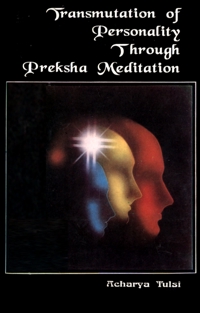
Unbridled play of the senses! incessant, attached, blatant functioning;
Impetuous, petty, bold, and feigning,
Indisciplined, arrogant, cruel, overcome by sleep, sloth and lust;
Predominantly black; all these show one possessed of krishna leshya.
Envious, angry, proud, shameless, ignorant, inaustere,
Deceitful, drunk, malicious, wicked, gluttonous, ever-seeking
Pleasure, ever-preoccupied, mean, insolent, guilty and vain;
Deceptive; blue-coloured---typical product of neel leshya!
Perverse in conduct and speech, insincere, sinful wretch
Full of guile, hiding self-defects, ingoble mendacious,
Jocular, speaking vile, thieving, jealous, violent;
Green his colour, of kapot leshya sure sign!
While discussing the current of feeling and the aura, you said that these could also be known from the conduct of the individual concerned. In order to identify an unclean feeling or aura, what attributes do we look for?
Unclean, disorderly feeling or inauspicious leshya and a filthy aura can be identified from the instincts and actions of the individual concerned. Violence, untruth, stealing, lust, possessiveness, accumulation of material objects, mental, verbal and physical flightiness, pettiness, audacity, arbitrariness, sensual indiscipline, cruelty, excessive sleep, and sloth - on the basis of these attributes, it can be concluded that the feelings of krishna leshya are primarily at work in a particular individual and his aura is predominantly black. The above-mentioned attributes are possible only in a state of krishna leshya.
The behaviour of all those possessed of krishna leshya is not similar. There can be wide variations. In the language of the Agamas, it is called chhathhanvarya, which literally means that the thought or conduct of one krishna leshya being, as compared to other krishna leshya living being, can be infinitely 'more unfortunate' or 'more lacking in merit.'
Envy, anger, pride, effrontery, ignorance, illusion, negligence, malice, wickedness, gourmandism, and constant desire for comfort, voluptuousness, ceaseless activity, meanness and boldness - these attributes indicate the predominance of neel leshya.
Crookedness of behaviour, obliquity of speech, duplicity and deceit, the desire to hide one's defects, falsehood, excessive jocularity, vile utterance, thieving, malice, and violence - these are the attributes of kapot leshya.
Krishna, neel, kapot - all the three are inauspicious leshyas. All effort stands vitiated by their virulence and impurity. And the shabbiness of effort affects one's conduct. The purification of leshya and action alone promotes good conduct.
Outwardly, some people appear to be religious. They faithfully perform all the rituals of the received tradition. But their instincts remain unsublimated. Is mere outward show or self-exhibition an adequate basis for the determination of one's leshya?
Outward exhibition is of little use in the determination of leshya. How can there be any decisiveness in conduct, if there is only exhibition of religiosity, and no religion at all. No fleeting tendency can provide a factual analysis of a person's individuality. The determination of leshya depends upon long-term activity.
Sometimes one can be mistaken in assessing a person's conduct. Similarly, there is the possibility of negligence in understanding leshya. In fact, leshya is much more connected with a person's behaviour.
Wherever there is a display of religiosity, life turns into a kind of farce. The tendency to hide one's defects and to put a gloss on one's conduct may deceive another person. Still the deception cannot last for long. Continued cohabitation cannot but lay bare the fundamental nature of a man. The story of Rama, the heron and the fish in this connection adduced earlier, highlights the fact that religiousness may be feigned, but such deception is short-lived. The moment the curtain of artificiality falls, the true nature of a person stands revealed.
Every sensible person would want that unclean leshya does not dominate his life. What should he do to ensure this?
Clean leshya can influence unclean leshya and vice versa. For one to influence the other, there is a need to make it strong. If clean leshya is stronger, the unclean leshya cannot influence it. It is a kind of a race. Whoever gets in the lead, dominates the other. Therefore, one must exert to make clean leshya stronger and more effective.
In our view, one way of making clean leshya strong is the creation of an armour. Many mantra-sadhaks have recourse to it to protect themselves from inauspicious outer influences. Some sadhaks make themselves a hardy defence, a Parshvanath shield. The novices make use of a mantra, also body-armour. Different communities use different mantras. This is the method commonly employed for avoiding the danger of external influences.
The second method is awareness, eternal wakefulness. If one's aim is to be constantly open to good feelings, bad feelings would have no occasion to manifest themselves. An accident takes place only when attention flags. This equally applies to the influence of unclean leshya. If a man is fully alert and aware of himself from moment to moment, no undesirable element could dominate him.
The strengthening of clean leshya, building a self-protective armour, total awareness - with these any person can fulfil his urge to be free from the influence of unclean leshya, and lead a life free from contradiction.
 Acharya Tulsi
Acharya Tulsi
